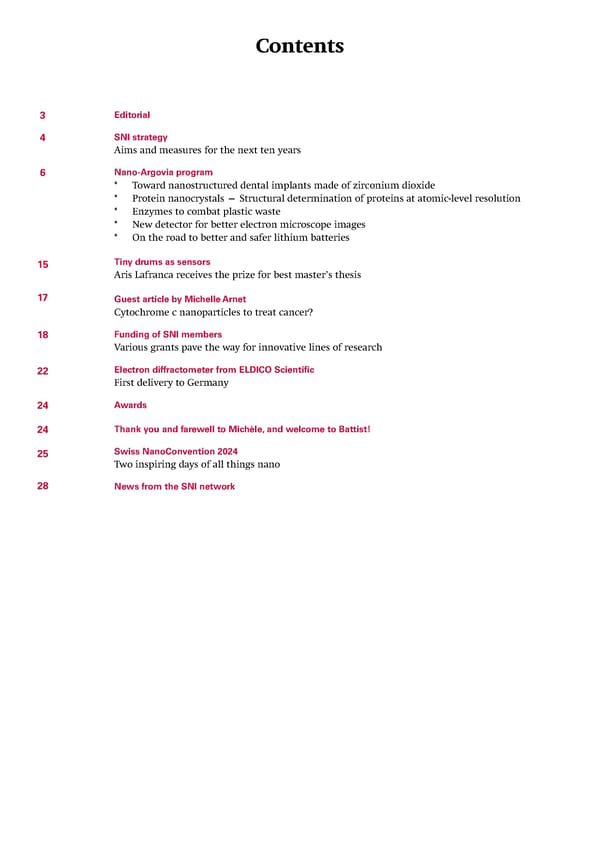SNI INSight June 2024
#nanoscience #nanotechnology #interdisciplinary research
SNI INSIght - Showcasing research and activities at the Swiss Nanoscience Institute
#nanoscience #nano #nanotechnology #innovation #applied research #study program #graduate school #quantum #life sciences #nanomedicine #environmental
SNI INS ight Showcasing research and activities at the Swiss Nanoscience Institute June 2024 Roadmap Application Award Exchange SNI strategy for the New projects in Prize for the best Successful next 10 years the Nano-Argovia master’s thesis Swiss NanoConvention program
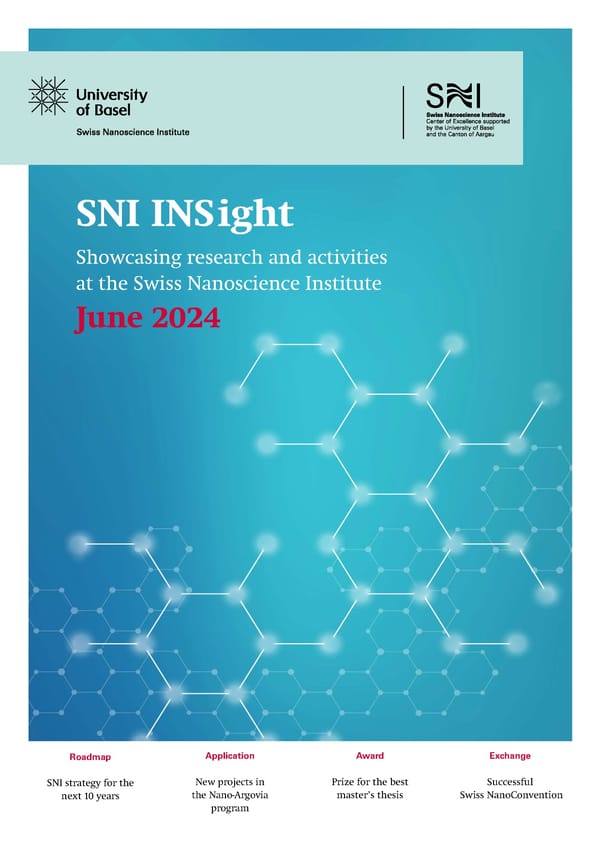
Contents 3 Editorial 4 SNI strategy Aims and measures for the next ten years 6 Nano-Argovia program * Toward nanostructured dental implants made of zirconium dioxide * Protein nanocrystals — Structural determination of proteins at atomic-level resolution * Enzymes to combat plastic waste * New detector for better electron microscope images * On the road to better and safer lithium batteries 15 Tiny drums as sensors Aris Lafranca receives the prize for best master’s thesis 17 Guest article by Michelle Arnet Cytochrome c nanoparticles to treat cancer? 18 Funding of SNI members Various grants pave the way for innovative lines of research 22 Electron diffractometer from ELDICO Scientific First delivery to Germany 24 Awards 24 Thank you and farewell to Michèle, and welcome to Battist! 25 Swiss NanoConvention 2024 Two inspiring days of all things nano 28 News from the SNI network
Editorial mittee and the Argovia Committee and that will now serve as a roadmap for the coming years. Now, it is time for the real work to begin — and it is up to all of us to put theory into practice. Speci昀椀cally, this means focusing on the key areas of nanoimaging and nanofabrication in the 昀椀elds of materials science, quan- tum science, life science, medicine and the environment, as well as bolstering and expanding collaboration within the network, adapting our programs and equipment to changing circumstances and, ultimately, ensuring that our activities are a source of inspiration for the general public. The Nano-Argovia program is an excellent exam- ple of how we’re already well on the way to implement- SNI INSight, we present ing this strategy. In this edition of 昀椀ve new projects that were launched at the start of this year, all of which feature collaboration across di昀昀erent disciplines and institutional boundaries. Dear colleagues and nanoenthusiasts, The description of the applied Nano-Argovia proj- ects helps to ensure that members of our network are Many of us met at the Swiss NanoConvention in Basel in informed about research activities of associated research early June, where we learned about numerous advances in groups. To further encourage interdisciplinary exchange, nanoresearch and had the opportunity not only to refresh there is a new section of SNI INSight in which we report old contacts, but also to make new ones. This was the on grants received by SNI members — even if they don’t fourth time that the SNI team had organized this interdis- come from the SNI. Please tell us about any relevant news ciplinary conference with a view to supporting interdis- so that we can relay this information as fully as possible. ciplinary exchange. All of the speakers, chairs, sponsors Of course, there are always people behind the and organizers deserve a big thank you — particularly our research we present — and we report on some of these outreach manager Kerstin Beyer-Hans, who was in charge individuals in this edition of SNI INSight. For example, of organizing and coordinating the event and played a Aris Lafranca from my team is receiving this year’s prize key part in the conference’s success. As part of this year’s for the best master’s thesis in nanosciences, and in the event, I was particularly pleased to invite some 60 pupils guest article, Michelle Arnet reports on her time at the to “TecDays meets SNC”, where we hopefully provided the University of Cambridge, where she completed her mas- next generation of researchers with fascinating insights ter’s thesis thanks to an Argovia Travel Grant. into the world of the nanosciences. In this issue, we’d also like to say a heartfelt As we see in our everyday work, those attending thank you to our outreach manager Michèle Wegmann, the SNC will once again have found that the nanoscienc- who has been a committed member of the SNI manage- es are incredibly diverse. On the one hand, this diversity ment team over the last eight years. Michèle is leaving makes them an exciting and attractive 昀椀eld of study. On the SNI and, from this summer, will work as an elemen- the other hand, it also presents certain challenges. It is tary school teacher in her local area. We wish her all the important that, as a research organization, educational best as she takes on this new challenge and would like to institution and service provider, we avoid spreading our- welcome her successor, the nanoscientist Battist Utinger, selves too thinly by trying to engage in every area. Rather, to the SNI team. we need to focus on certain core areas of the nanosciences — because this is the only way to achieve and maintain With that, I hope you enjoy reading SNI INSight and I excellent standards. look forward to hearing your feedback. In various committees over the last year, we’ve discussed what this focus should look like in detail and Kind regards, what other guiding principles we should strive for as we look to the future of the SNI, and we’ve set these aims out in a strategy paper geared toward the next 10 years. This process began over a year ago with preparations in the management team and a workshop attended by both Prof. Martino Poggio, SNI director internal and external colleagues, who gave their recom- mendations. After further discussions, we compiled a document that has been approved by the Executive Com- SNI INSight June 2024 3
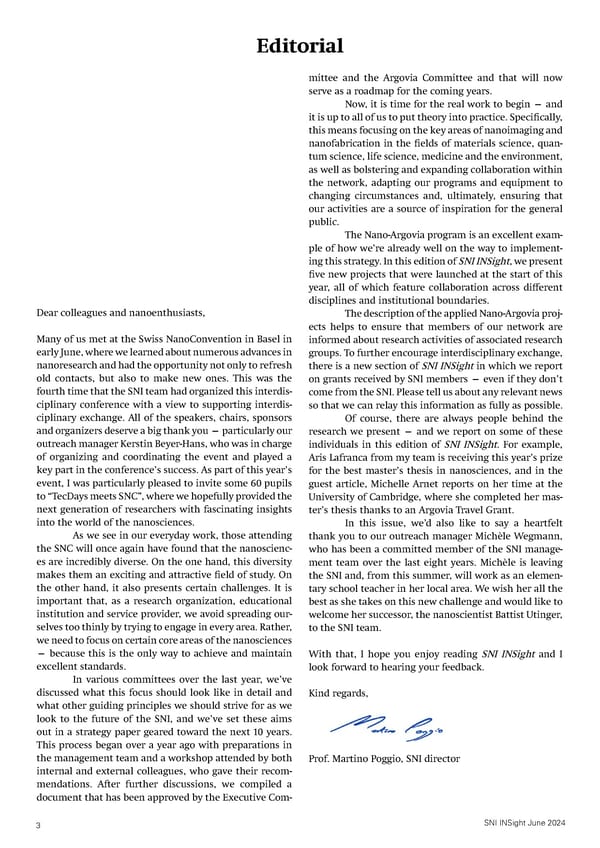
SNI Strategy Aims and measures for the next ten years In its Strategy 2024–2034, the Swiss Nanoscience Institute (SNI) provides a road- map for its targeted development over the next ten years. The ultimate aim is to position the SNI such that it can put its extraordinary expertise in nanoscience and nanotechnology to use in addressing the challenges facing society. We aim to be a lighthouse for research, education and innovation in nanoscience and this strategy paper serves as a guide for members of the interdisciplinary network, the Universi- ty of Basel, political decision-makers and the general public to reach this goal. Four guiding principles Close collaboration is crucial for The SNI’s four guiding principles for the future are to the success of an interdisciplinary focus, collaborate, adapt and impact. network like the SNI. Thanks to the SNI’s established structure, re- Over the next decade, the SNI will searchers from di昀昀erent disciplines focus on the core areas of nanoim- Collaborate and institutions work together on aging and nanofabrication. The SNI’s basic and applied research ques- predecessor institution and the SNI tions. The aim for the future is to itself were founded by scienti昀椀c pio- strengthen identi昀椀cation with the SNI network among neers, who were among the 昀椀rst to its members, to create a stronger sense of “we” and to Focus visualize and manipulate structures communicate the SNI’s achievements together. at the nanoscale. Building on this tra- dition of excellence, we aim to consolidate and expand In order to compete with the best our expertise in these areas. This will help us to address nanoscience centers in the world, challenges in the 昀椀elds of materials science, quantum we must adapt our infrastructure to science, life science, medicine and the environment. As the ever-increasing technological de- part of these e昀昀orts, we will involve all parts of the SNI, mands of the coming years. We will including fundamental and applied research, our service Adapt also continue to modernize the train- units (Nano Imaging and Nano Fabrication Lab), and our ing of young scientists and make the educational program. way in which we present information about our activities more and more attractive. SNI INSight June 2024 4
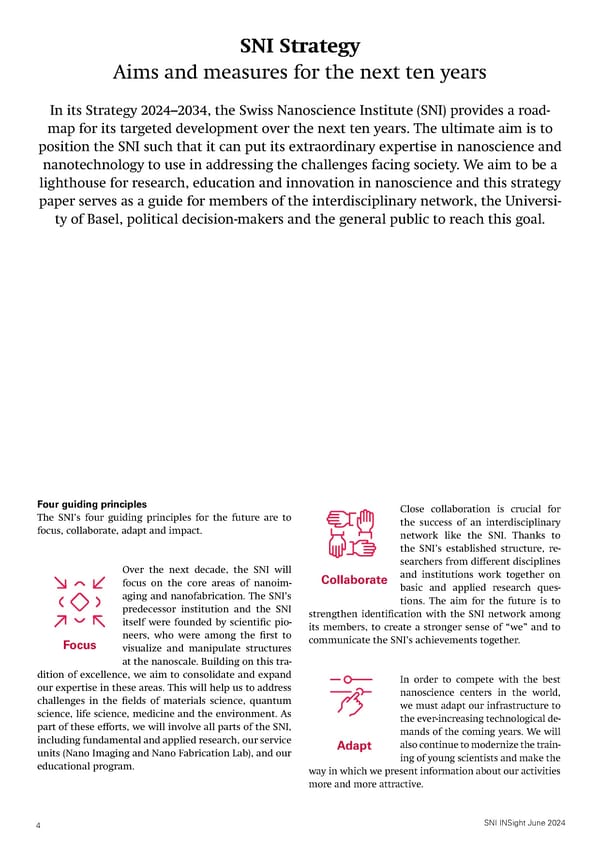
Further The SNI’s work will have Modern equipment for research groups and information an impact on society, on service units is fundamental in the rapidly the one hand, through changing 昀椀eld of nanosciences and nano- Strategy 2024-2034 the success of basic and technology. With this in mind, the SNI will https://nanoscience.unibas. applied research on is- therefore work to ensure that state-of-the-art ch/fileadmin/user_upload/ nanoscience/04_UEber_Uns/ sues for which nanotech- infrastructure allows research at the highest Organisation/Strategy-Pa- Impact per_en_final_28_5_24.pdf nologies o昀昀er solutions. level. On the other hand, it The SNI team will step up e昀昀orts to will have an impact by providing specialized engage in e昀昀ective knowledge and technol- services beyond the network, through the ogy transfer — after all, it will only be pos- training of excellent young scientists and sible to exploit the potential of innovations through active outreach. developed in the research groups of the SNI network (CSEM Allschwil, D-BSSE, FHNW, Relevance in all areas PSI, ANAXAM, Swiss PIC and the University The four guiding principles are re昀氀ected in of Basel) if we succeed in transferring appli- planned measures a昀昀ecting all areas relevant cations of our research 昀椀ndings to compa- to the SNI. nies. The Nano-Argovia program, which has For the network, it is important to existed since the time of the SNI’s founding, further expand the interdisciplinary and in- will continue to operate in order to promote terinstitutional community over the coming exchange between researchers from the SNI years. With its shared goals, this community network and from industrial companies in is characterized by excellence in research Northwestern Switzerland as well as jointly and identi昀椀cation with the SNI. We will developing new products and applications. also expand the network’s reach by further In terms of public relations, the SNI stimulating exchange with the nanoscience is keen to generate a positive association with community at the national and international the terms “nanoscience” and “nanotechnolo- level. gy.” The objective is to report on the achieve- In terms of education, we will focus ments of SNI researchers in an entertaining on training committed young nanoscientists manner and to share our fascination with the who are ideally equipped to master the com- nanoworld. This involves not only informing plex challenges of the future thanks to their the wider public, but also getting children broad knowledge base. The SNI will there- and young people excited about studying a fore continually adapt the curriculum of the natural science or the nanosciences. degree program and step up e昀昀orts to get schoolchildren excited about this demanding course of studies. We will make the course and the PhD School more attractive by consolidat- ing the links between education and the SNI’s research and service activities. We will strive for closer collaboration with AlumniNano with a view to helping nanoscience students learn about research approaches outside the network and gain a better overview of poten- tial career pathways. The SNI will concentrate its research and service activities on the areas of nano- imaging and nanofabrication in order to de- liver solutions to the challenges facing soci- ety. In the future, there will be closer links between the di昀昀erent research groups and the Nano Technology Center (Nano Imaging Lab and Nano Fabrication Lab), which was founded in 2022. The portfolio of customers and partners is to be expanded over the com- ing years — including through contact with other national and international nanocenters. SNI INSight June 2024 5
Nano-Argovia program This year, the SNI is supporting 10 applied research projects in collaboration with industrial companies from Northwestern Switzerland. Five of these projects began in January 2024, while the rest have been in progress since 2023. Here, we o昀昀er a brief presentation of the new projects. Toward nanostructured dental implants made of zirconium dioxide In the Nano-Argovia project ZIRYT, an interdisciplinary team is investigating how a nanostructured surface can be used to produce zirconium dioxide dental implants that o昀昀er an aesthetically pleasing and metal-free alternative to titanium implants. Seeking an alternative Titanium implants have become the main choice for tooth replacement. As patients increasingly demand more aes- thetically pleasing and metal-free solutions, however, re- searchers are looking for suitable alternatives. The team around project leader Dr. Nadja Rohr (University Center for Dental Medicine Basel UZB, University of Basel) sees great potential in the increased use of zirconium dioxide as a substitute for titanium. The researchers are work- ing with Professor Géraldine Guex (UZB) and the project partners Professor Michael de Wild (IM2, FHNW) and Dr. Raphael Wagner (Institut Straumann AG) to develop the basic principles for further optimizing the surface of zir- conium dioxide implants. Currently, the surface of the implant section The team working on the Nano-Argovia project ZIRYT uses various zir- anchored in the jaw is sandblasted and etched with conium dioxide disks to study the interaction with different cell cultures. acids in a complex process to create a suitable surface microstructure that supports the ingrowth of bone cells. In the Nano-Argovia project ZIRYT, researchers are now working to produce a nanostructured surface using only targeted heat treatment. This is possible because, under the in昀氀uence of heat, zirconium dioxide forms crystals on the surface that create the nanostructure. Nanostructure with ideal properties The Nano-Argovia project ZIRYT aims to determine how the nanostructuring of the zirconium dioxide sur- face a昀昀ects the integration of bone tissue in vitro. The researchers are investigating the in昀氀uence of di昀昀erent starting materials and heat treatment processes on the crystal structure and therefore on surface topography. Using state-of-the-art analytical methods and di昀昀erent The researchers examine the growth of various cell cultures on zirconi- um dioxide samples. SNI INSight June 2024 6
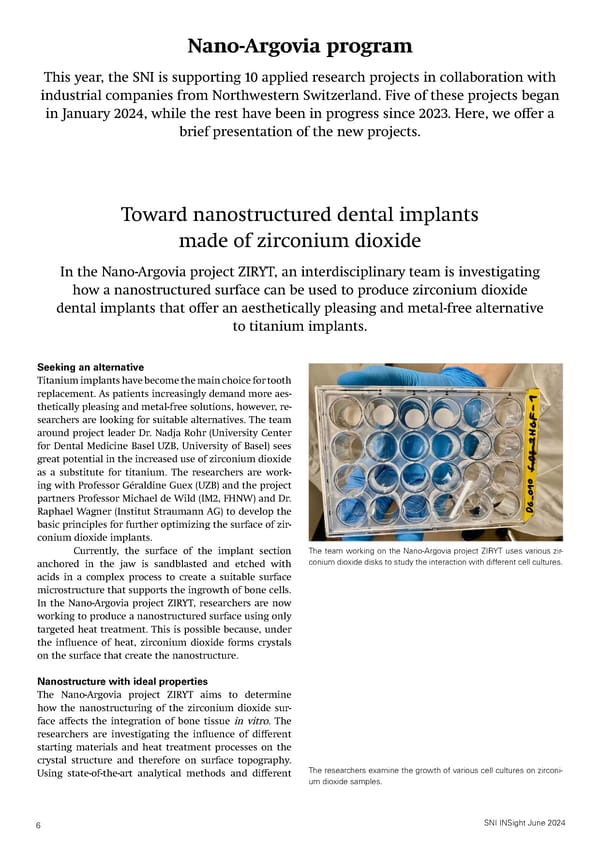
Further cell culture models, the researchers evaluate information the interaction between implant material and tissue. Nano-Argovia In this way, they will determine the program ideal surface structure and de昀椀ne the require- https://nanoscience.unibas.ch/ en/forschung/applied-research/ ments for manufacturing. The project will help facilitate the production of next-gener- UZB ation zirconium dioxide dental implants for https://www.uzb.ch the bene昀椀t of patients. FHNW School of Life Collaboration between: Sciences University Center for Dental Medicine https://www.fhnw.ch/en/re- search-and-services/lifesciences Basel UZB of the University of Basel // IM2, FHNW School of Life Sciences // Straumann Institut Straumann AG (Basel) Géraldine Guex discusses how the experiments are per- https://www.straumann.com/en/ formed with master’s student Daniel Gauss. dental-professionals.html “We believe that zirconium dioxide-based dental implants will grow to become a signi昀椀cant market in the coming years. For this reason, we’re particularly interested in the results of the ZIRYT project, which has the potential to optimize both the complex- ity of the manufacturing process and the clinical results of our products — for the bene昀椀t of patients. Our long-standing and successful collaboration with the UZB, the University of Basel and the FHNW encourages us to continue supporting these centers of competence in their excellent research.” Dr. Raphael Wagner, Institut Straumann AG (Basel) Nano-Argovia program Submit your project proposals! In the Nano-Argovia program, the SNI promotes applied nano- technology research projects. Companies from Northwestern Swit- zerland work together with partners from at least two di昀昀erent academic institutions. Submit your project proposals by September 30, 2024. Information about the Nano-Argovia program and proposal require- ments can be found at: www.nano-argovia.swiss For an overview about the Nano-Argovia program, we’ve put togeth- er a new 昀氀yer that o昀昀ers an overview of the Nano-Argovia program. https://bit.ly/3KoqurE SNI INSight June 2024 7
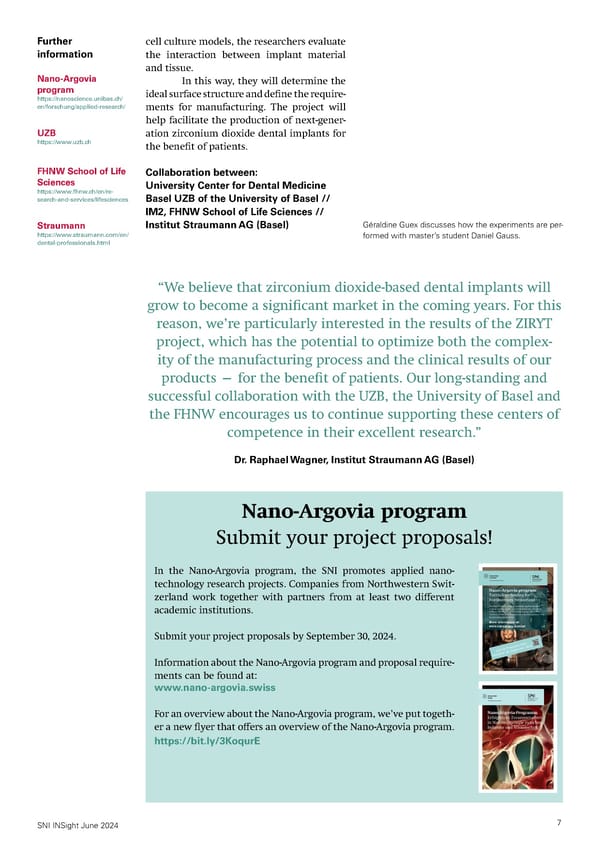
Protein nanocrystals — Further information Structural determination of proteins Paul Scherrer Institute PSI at atomic-level resolution https://www.psi.ch/en using electron di昀昀raction Biozentrum, University of Basel https://www.biozentrum.unibas. The team in the Nano-Argovia project ProtEDinNanoxtals aims to ch use electron di昀昀raction to investigate the role of hydrogen atoms leadXpro in protein function, as well as interactions between proteins and https://leadxpro.com ligands. By doing so, the researchers will gain insights into the ELDICO Scientific structure of proteins at the atomic level and a better https://www.eldico-scientific. understanding of vital biological processes, thereby com supporting drug development. Hydrogen is always involved the active sites of proteins. In this method, Hydrogen atoms play a decisive role in the accelerated electrons hit the sample and are structure, stability and function of proteins di昀昀racted due to interactions with atoms — the nanomachines that organize the life inside the thousands of protein molecules and shape of our cells. Hydrogen atoms are that are arranged symmetrically within the the lightest but most abundant atoms on our nanocrystal lattice. The position of the at- planet. They help to stabilize the three-dimen- oms — and therefore of the molecules — in sional shape of proteins by interacting with the sample can be calculated based on the other atoms — that is, by forming hydrogen di昀昀raction patterns obtained. Recent years bonds — and also participate in the biolog- have seen huge progress in the development ical function of the proteins themselves. of electron di昀昀raction measuring devices and Knowledge of the hydrogen coordinates in sample preparation, paving the way for their the protein structure at the active center is use on various proteins. therefore crucial for the development of new A diverse team of experts led by Dr. active pharmaceutical ingredients, but the Valérie Panneels (Paul Scherrer Institute) limitations of conventional methods mean it will now analyze model proteins of di昀昀erent is di昀케cult for scientists to map the location sizes and functions. These proteins are pho- of hydrogen atoms in proteins. tosensors that are inactive in the dark and for which the resting structure is known. First, Electron diffraction as the method an electron microscope and a horizontal of choice electron di昀昀ractometer will be used to mea- Now, the interdisciplinary team working on sure light-oxygen-voltage-sensing domain 1 the Nano-Argovia project ProtEDinNanoxtals (LOV-1), a small domain responsible for the is planning to use electron di昀昀raction to in- regulation of various functions by light per- vestigate the position of hydrogen atoms at ception in organisms from prokaryotes to “leadXpro is specialized in membrane protein structure-based drug discovery with the help of X-ray crystallography and cryo-EM for the discovery of novel medicines. Electron di昀昀raction could evolve as a vital complementary technology for nanocrystals, as well as for the analysis of hydrogen atoms.” Dr. Michael Hennig, leadXpro 8 SNI INSight June 2024
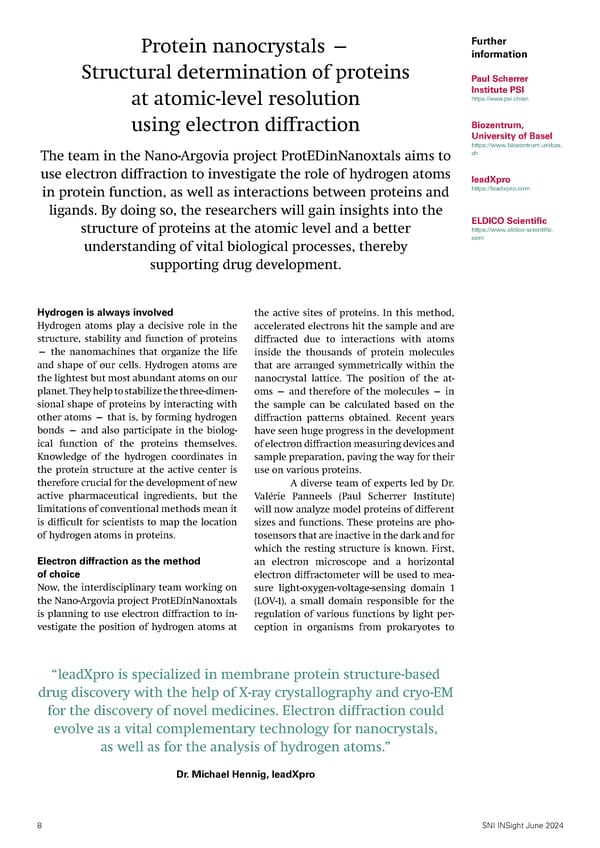
eukaryotes. In parallel, the researchers will measure and interaction of proteins with their functional ligands. The analyze rhodopsin, a larger protein that is responsible method allows everything from resolution at an atomic for the process of vision. Following these investigations level to information on the hydrogen content, and the with known model proteins, the team will then examine project will therefore make a substantial contribution nanocrystals of further membrane proteins of pharma- to revealing the mechanisms of action of potential phar- ceutical interest. The quality of the data will depend on maceutical ingredients. Ultimately, the researchers will the perfect ordering of the protein crystals, which must add the generated structures to corresponding databases, be very thin, nanometer-size crystals in order to reduce in which structures obtained by electron di昀昀raction are multiple-scattering events. signi昀椀cantly underrepresented at present. With this project, the research team hopes to highlight the advantages of electron di昀昀raction as a Collaboration between: complement to other structural biology techniques and Paul Scherrer Institute // Biozentrum, University of therefore to improve the methodology by applying it to Basel // leadXpro AG // ELDICO Scientific AG membrane proteins in order to gain new insights into the In the Nano-Argovia project ProtEDinNanoxtals, researchers are analyzing how electron diffraction complements other structural biology techniques to gain new insights into the interaction of proteins with their functional ligands. (Image: PSI) “ELDICO was the 昀椀rst company to produce commercially available devices that are dedicated to electron di昀昀raction (ED) crystallography. In addition, via its applica- tion center in Basel, it constantly re昀椀nes this method and frequently o昀昀ers ED as a service to customers in the pharmaceutical industry. In this project, ELDICO will work hand in hand with partners to help expand the potential use of ED on proteins — and especially on challenging membrane proteins.” Dr. Gunther Steinfeld, ELDICO Scientific AG SNI INSight June 2024 9
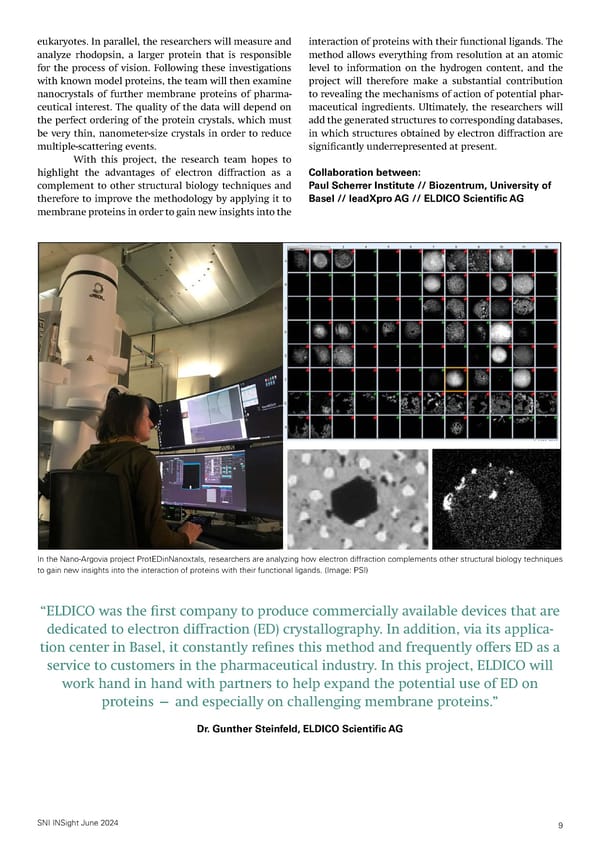
Enzymes to combat plastic waste In the Nano-Argovia project NANOdePET, an interdisciplinary team is developing a sustainable method to enable the enzymatic degradation of polyethylene terephthalate (PET) plastic. Using nanotechnology, the researchers working on the project supramolecularly engineer enzymes to equip them with the ability to degrade PET e昀케ciently. The second phase of the project will examine the possibility of implementing the resulting technology on an industrial scale. Demand for sustainable recycling methods Worldwide, more than 55 million tons of the plastic poly- ethylene terephthalate (PET) are produced every year, and this volume will continue to rise in the future. The main applications are packaging (bottles and 昀椀lms) as well as fabrics and textiles. Accordingly, there is an urgent need for innovative measures to prevent a continuous increase in the environmental burden and to enable the reuse of this versatile polymeric material. Today, in industrial- ized countries, this is primarily achieved by mechanical methods with subsequent melting down and reuse of the material — but this technique produces harmful waste and only allows a limited number of cycles, as the quality of the material decreases with each cycle. Alternative chemical methods developed so far, Amir Nazemi is preparing a protein quanti昀椀cation assay to study the im- which allow processing of the building blocks back into mobilization ef昀椀ciency and measure the amount of enzyme immobilized high-quality PET, are not only energy-intensive and costly on the silica nanoparticles. (Image: FHNW) but also associated with detrimental waste. One solution would involve the enzymatic degradation of PET, but known PET-degrading enzymes are thermally unstable and costly to use. developed by INOFEA to modify the nanoenvironment of Modified enzymes with improved properties PET-depolymerizing enzymes (ester hydrolases) so that Now, a team of researchers from the FHNW School of Life they exhibit higher stability and a better conversion rate Sciences and School of Engineering is working with the than soluble enzymes. start-up INOFEA to develop a sustainable PET-degradation Using nanotechnological methods, natural en- method based on enzymatic hydrolysis. The researchers, zymes are immobilized on a silica core and stabilized led by Professor Patrick Shahgaldian, are using a platform using arti昀椀cial “chaperones.” A coating of organic silica “This collaboration with FHNW, 昀椀nancially supported by the SNI, o昀昀ers INOFEA an opportunity to expand its portfolio of nano-engineered enzymes and address envi- ronmental concerns by providing a sustainable solution to plastic waste. INOFEA expects to gain a competitive edge and meet market demand for environmentally friendly products.” Dr. Rita Correro, INOFEA SNI INSight June 2024 10
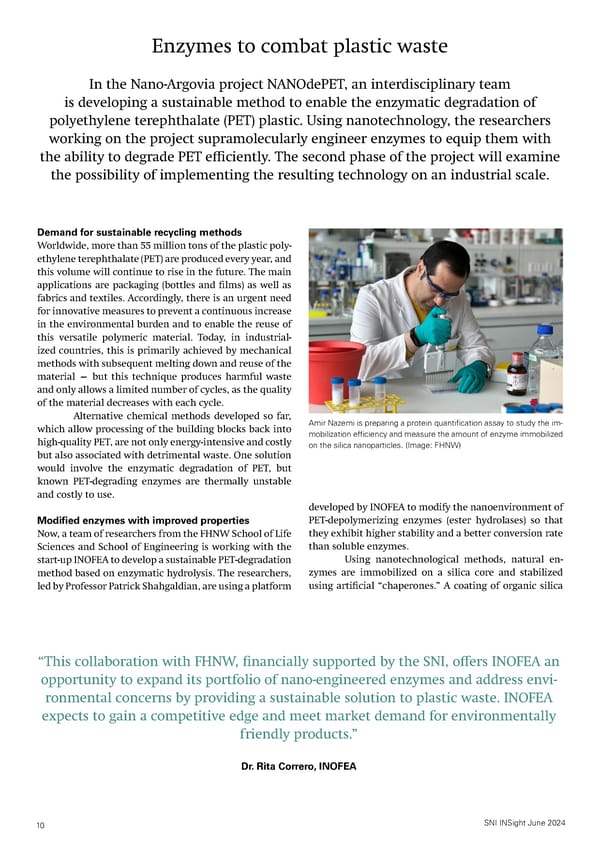
Further with a controlled thickness protects the en- the team will compare the results with the information zymes from external in昀氀uences but allows recycling methods that are currently in use the enzymatic degradation of PET. today and evaluate the method’s suitability FHNW School of The researchers will 昀椀rst test suit- for industrial PET recycling. Engineering able enzymes and produce various nanosys- https://www.fhnw.ch/en/ research-and-services/engi- tems. These systems will then be tested for Collaboration between: neering PET degradation, and a recycling process will School of Life Sciences and School of FHNW School of Life be established on a laboratory scale. Next, Engineering, FHNW, and INOFEA AG Sciences https://www.fhnw.ch/en/re- search-and-services/lifesciences INOFEA https://www.inofea.com Immobilized and stabilized natural enzymes are coated with organic silica of controlled thickness. In this way, the enzymes are protected from external in昀氀uences but are still able to degrade PET. (S.A.Nazemi, FHNW) Annual Event 2024 The next Annual Event will be held from 4 to 6 September. We look forward to wel- coming as many of our members as possi- ble to this year’s event at Hotel Seerose at Lake Hallwil. Video with impressions of the Annual Event 2023. SNI INSight June 2024 11
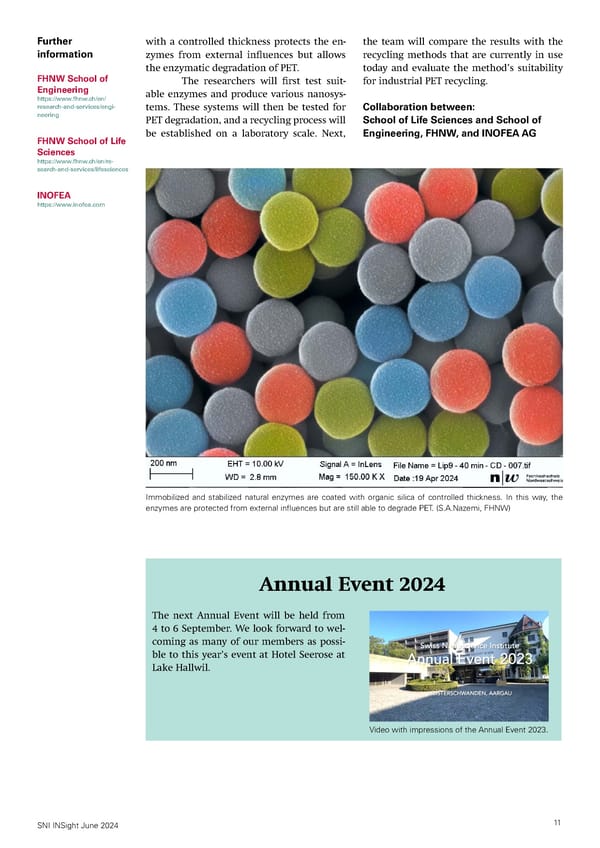
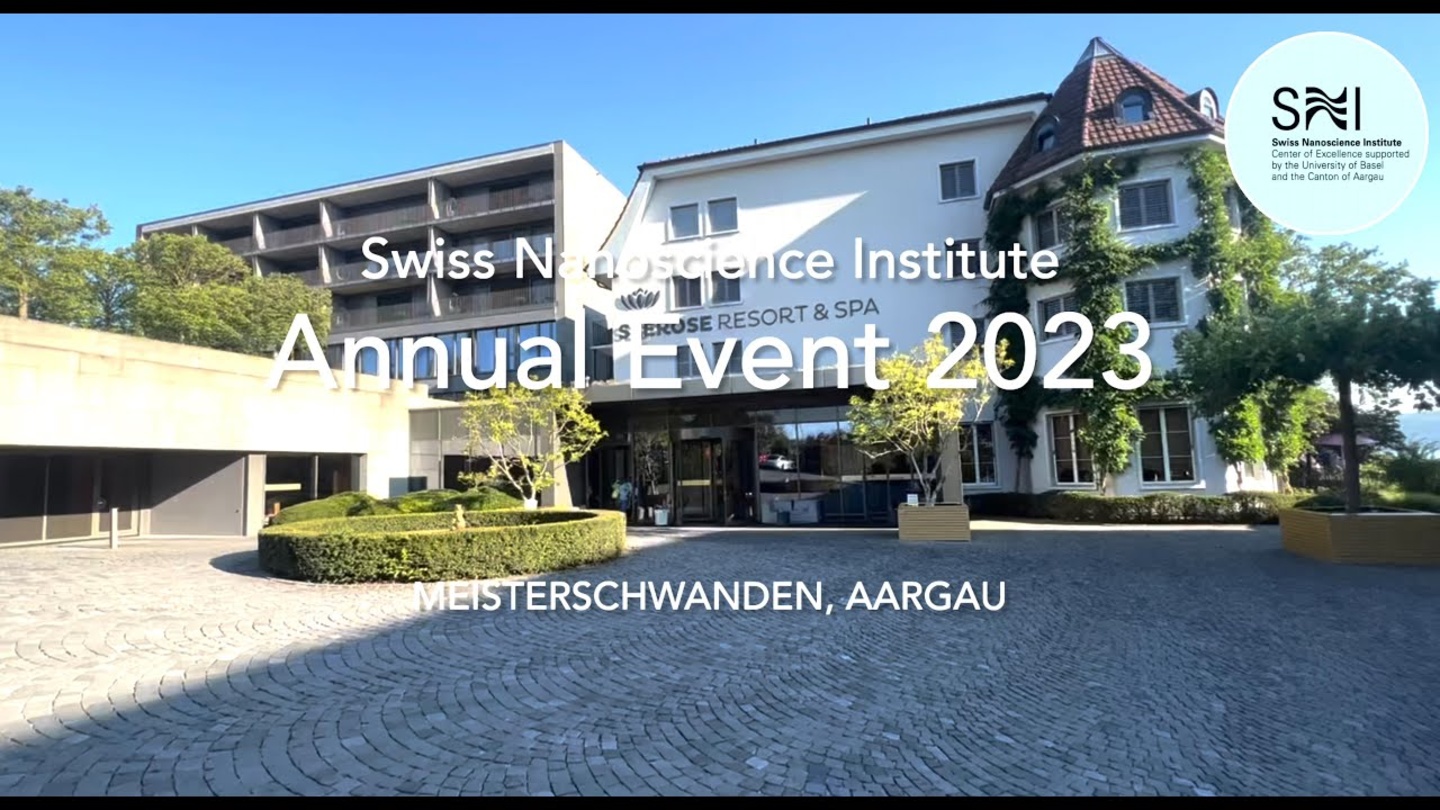
New detector for better Further information electron microscope images Paul Scherrer Institute PSI Researchers working on the Nano-Argovia project HiZfEM are https://www.psi.ch/en planning to develop a new electron detector with improved Biozentrum, image quality for transmission electron microscopy. To this end, University of Basel https://www.biozentrum. the interdisciplinary team of researchers from the Paul Scherrer unibas.ch Institute PSI, the University of Basel and the industrial partner DECTRIS DECTRIS AG (Baden, AG) is applying the experience it has gained https://www.dectris.com/en/ from developing other hybrid pixel detectors for photon science. Improvements are possible thicker silicon sensors, which are needed to Today, “complementary metal-oxide-semi- protect their more sophisticated signal pro- conductor” (CMOS) detectors are the most cessing circuitry from incident high-energy popular detector for high-performance trans- electrons. The decisive advantage of hybrid mission electron microscopes. They are based pixel detectors over CMOS detectors is the on the semiconductor material silicon and possibility of using sensor materials other consist of an array of light-sensitive pixels than silicon in order to improve the detec- that are integrated on a single chip together tion capabilities of the detector system. The with the signal processing circuit. In contrast, use of sensor materials with a higher electron hybrid pixel detectors are made up of two density should signi昀椀cantly improve image separate layers in which the sensor part is sharpness, as demonstrated by simulations separated from the readout part. At present, and recent experimental studies. comparatively thick silicon sensors are also used with hybrid pixel detectors in electron Change of detector material microscopy, but their imaging performance In the Nano-Argovia project HiZfEM, the is limited due to multiple scattering in their researchers led by Dr. Dominic Grei昀昀enberg Researchers working on the Nano-Argovia Project HiZfEM plan to improve image quality in transmission electron microscopy by using new detector modules such as this one made of chromium-doped gallium arsenide (8 x 4 cm²). 12 SNI INSight June 2024
from the Paul Scherrer Institute PSI are planning to use involved are optimistic that, by using the heavier sensor gallium arsenide (GaAs) doped with chromium instead of material, they will also be able to improve the quality of silicon as a detector material in a hybrid pixel detector data delivered by the transmission electron microscope. and to quantify the advantages compared with CMOS detectors in a speci昀椀c electron energy range. Collaboration between: DECTRIS, one of the world’s leading manufactur- Paul Scherrer Institute PSI // Biozentrum, University ers of hybrid pixel detectors, is providing the novel sensor of Basel // DECTRIS AG (Baden, AG) material GaAs:Cr for the investigations. The researchers “We’re thrilled to collaborate on the HiZfEM project, where our advanced GaAs material will play a crucial role in pushing the boundaries of electron microscopy. This collaboration with esteemed institutions like the Paul Scherrer Institute and the University of Basel underscores our commitment to pioneering scienti昀椀c advancement and solidi昀椀es our position at the forefront of hybrid pixel detector technology.” Dr. Sonia Fernandez, DECTRIS AG On the road to better and safer lithium batteries In the Nano-Argovia project BatCoat, researchers are investigating a “zero-excess lithium anode” for the next generation of lithium-metal solid-state battery cells, which represent a promising alternative to battery cells based on conventional lithium-ion technology. Li-metal solid-state battery cells have a higher energy density and are safer than the lithium-ion batteries currently used in electric cars, for example. They could therefore make a signi昀椀cant contribution to e昀昀ective, safe and sustainable electromobility, although there are still some technical limitations that the interdisciplinary team in the Nano-Argovia project BatCoat will seek to address. Better safety and stability Before reliable Li-metal solid-state battery cells can be- In the new Li-metal solid-state battery cells that are being come a reality, there are a number of technical hurdles investigated, the negatively charged electrode (anode) is that must be overcome — and this is where the Nano-Ar- not made of graphite/silicon, as is the case in lithium-ion govia project BatCoat comes in. The researchers, led by battery cells, but rather of three-dimensional (3D) copper project leader Dr. Mario El Kazzi from the Paul Scherrer onto which very thin surface-functional layers are depos- Institute PSI, are investigating how lithium can be homo- ited. The nanoscale functional layers help to uniformly geneously deposited on a copper surface and withstand and reversibly deposit and strip lithium as the only source more than 500 charge/discharge cycles with sustained in the cathode. Another key di昀昀erence from lithium-ion high capacity without the lithium reacting with the solid batteries is that solid-state battery cells have an electro- electrolyte. They hope to achieve this by depositing very lyte made of a solid lithium-ion-conducting material. This thin layers of di昀昀erent materials (with a thickness of
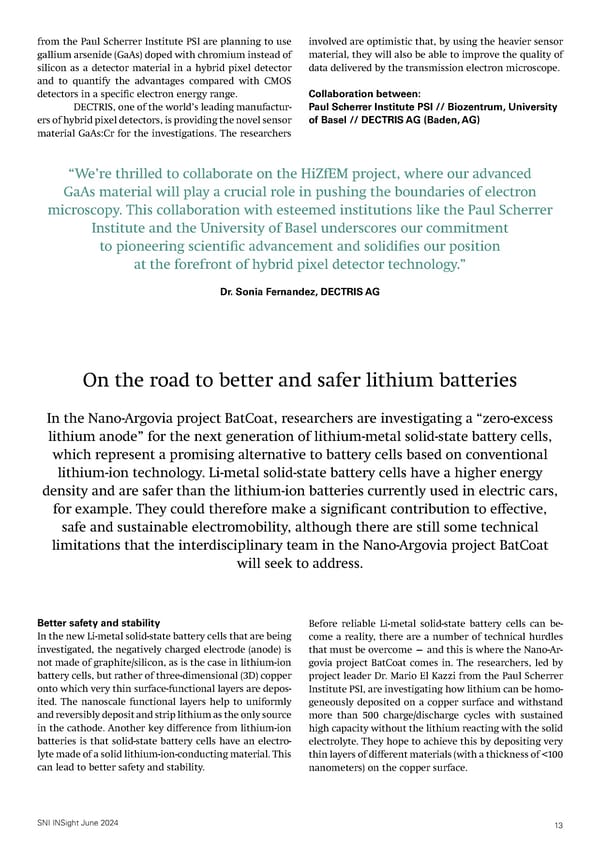
In collaboration with Professor Kaspar Lö昀昀el Further from FHNW, the researchers are also investi- information gating the bene昀椀ts of 3D copper as a promis- ing solution that could help to mitigate the Paul Scherrer formation of lithium dendrites on the anode, Institute PSI as these can have various negative e昀昀ects on https://www.psi.ch/en battery performance and safety. Finally, the FHNW School of researchers will develop a concept for pro- Engineering ducing these nanoscale functional layers on https://www.fhnw.ch/en/ 3D copper on an industrial scale. research-and-services/engi- neering Collaboration between: Oerlikon Metco Paul Scherrer Institute PSI // FHNW https://www.oerlikon.com/ School of Engineering // Oerlikon Metco metco/en/ AG (Wohlen, AG) The project team uses an all-solid-state cell for accurate and reliable electrochemical testing (top) and roadmaps the evolution of Li-ion battery chemistry, which can be used to boost energy density and improve safety. (Im- age: PSI) “The project potentially allows us to enter the value chain of Gen 3 and Gen 4 lithium-metal cell technology with a strong unique selling proposition.” Dr. Phani Kumar Yalamanchili, Oerlikon Metco AG Nano Fabrication Lab 昀氀yer The Nano Fabrication Lab (NF Lab) o昀昀ers numerous technolo- gies and methods to support researchers with the production of micro and nanofabricated components. We provide an overview of the NF Lab’s services in a short 昀氀yer. Nano Fabrication Lab flyer https://bit.ly/4dYGzln Annual Report 2023 In the Annual Report, we look back on the year 2023. In addition to short and concise summaries of highlights in di昀昀erent areas of the SNI, a scienti昀椀c supplement goes into greater depth and describes the results of all projects funded in 2023 over two pages per project. General part Animated version with embedded video, print version Scientific supplement Print version 14 SNI INSight June 2024
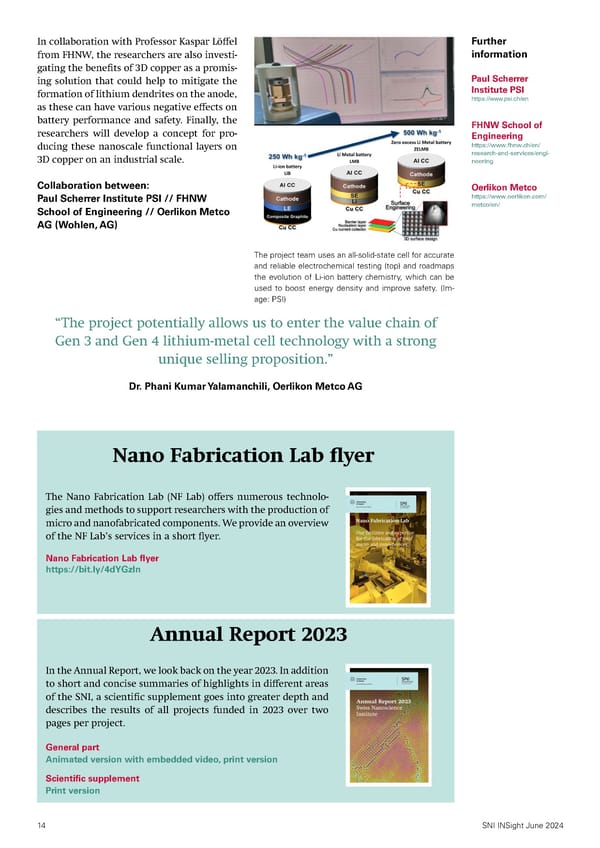
Best master's thesis
Aris Lafranca wins the prize for the best master's thesis in nanoscience at the University of Basel.
Further Tiny drums as sensors information Video with Aris Lafranca receives the prize Aris Lafranca https://youtu.be/UhcM43AK-7s for best master’s thesis Poggio Lab https://poggiolab.unibas.ch This year’s prize for the best master’s thesis in nanosciences at the University of Basel goes to Aris Lafranca. As part of the winning master’s thesis at the Department of Physics, the young nanoscientist from Ticino investigated a hybrid resonator in greater detail. Made of hexagonal boron nitride and a silicon nitride membrane, the resonator could potentially be used to measure forces, masses or acceleration, as well as for biomedical applications. Aris’ investigations sought to better characterize the system, and to monitor and control the in昀氀uence of temperature. Combination of positive properties When the tiny resonator is excited, the boron Aris already began investigating a tiny me- nitride layer — which is just a few atomic chanical hybrid resonator during his 昀椀rst layers thick — begins to vibrate. Due to the project work in the master’s program. These special properties of the materials, as well resonators consist of hexagonal 昀氀akes of as the resonator’s special construction, the boron nitride (hBN) suspended above holes resonator can be caused to vibrate not only in a silicon nitride membrane (Si N ) like by mechanical excitation but also by light, 3 4 the skin of a drum. Together, the hexagonal for example. Like in a drum, the resonator boron nitride and the silicon nitride mem- ampli昀椀es the signal such that it could po- brane form a unit that brings together the tentially be used as a component in sensor di昀昀erent properties of these two 2D nano- applications. materials. The researchers “read” the vibra- tions using light: A laser beam is divided into two beams, one of which strikes the vibrat- ing drum. When the two lasers meet again, they form interference patterns that vary in response to changes in the resonator’s vibra- tion. Decisive improvements For his master’s thesis, Aris investigated and characterized this two-dimensional hybrid resonator further using an improved ex- perimental setup that includes a Michelson interferometer. He was able to extend the setup in order to boost the signal-to-noise ratio and reduce temperature 昀氀uctuations. Thanks to these extensions, Aris can now control the sample temperature precisely — which is a fundamental prerequisite for his analyses. He also wrote a Python code that controls sample temperature automatically, Aris Lafranca completed the work for his award-winning and he demonstrated that his measurements master’s thesis in Martino Poggio’s team at the Depart- show good agreement with theoretical sim- ment of Physics. ulations. SNI INSight June 2024 15
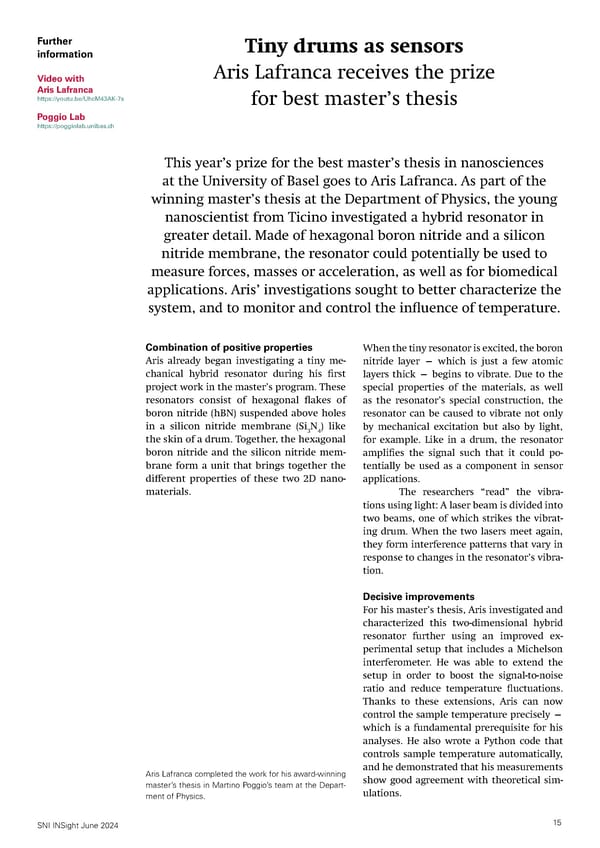
Master's project at University of Cambridge
Michelle Arnet did her master's thesis in nanoscience at the University of Cambridge and reports about the unique experience.
Simulations and measurements con昀椀rm that the hBN “It’s a lot of fun planning experiments of this kind, be- drum has a negative coe昀케cient of thermal expansion. ginning to take measurements, and then using the results “Contrary to what we know about most other materials, as the basis for solving problems and amending the plan boron nitride contracts in response to a temperature accordingly,” says Aris when asked what he 昀椀nds particu- increase,” explains Aris. “Since the boron nitride 昀氀akes larly fascinating about his work. The positive team spirit and the silicon nitride membrane form a unit, this con- was another factor in his decision to carry on where he traction leads to increased mechanical stress for the res- had left o昀昀 during his master’s degree in nanosciences. onator at higher ambient temperatures.” This additional stress a昀昀ects the boron nitride’s frequency and mode of An early decision vibration, while the frequency and mode of the silicon Aris had already decided to study nanosciences back in his nitride membrane remain largely unchanged. school days, when he learned about the interdisciplinary As the experimental setup now allows precise degree program in nanosciences at the University of Basel temperature regulation, it is possible to con昀椀gure the during “OrientaTI”, a student information event hosted mechanical stress inside the hBN drum — allowing re- by Università della Svizzera italiana (USI) for cantonal searchers to study interactions with the silicon nitride schools in Ticino. “For me, the combination of biology, membrane. physics and chemistry was the decisive factor,” he recalls. Things weren’t always easy when he started out at Further research on the topic Basel — as well as the technical challenges, he also had to For Aris, completing his master’s thesis is far from the end get used to the language. “The sense of community among of his interest in hybrid resonators. Since December 2023, the students helped me a lot, though, and it wasn’t long he has continued his work as a doctoral student in the before German was no longer a problem,” he says. team led by Argovia Professor Martino Poggio. He initially As well as the positive atmosphere among stu- took over the production of the tiny hBN drums, a process dents, he particularly enjoyed topics from the worlds of that had been developed — and carried out so far — by physics and chemistry during his studies — and, with the former SNI doctoral student Dr. David Jaeger as part of his hybrid resonators, the 昀椀rst project in his master’s degree doctoral thesis. In the future, Aris will attempt to couple led him to a topic that fascinated him and will keep him multiple hBN drums, investigate di昀昀erent thicknesses of busy over the years ahead. hBN membrane and test other samples. “Aris’ thesis is without a doubt the best and most expertly executed master’ thesis I have read here in Basel. I am very pleased that he has decided to continue working in experi- mental physics as a PhD student in my group.” Prof. Martino Poggio, Department of Physics, University of Basel Aris Lafranca uses a Michelson interferometer to investigate and charac- terize the two-dimensional hybrid resonator. SNI INSight June 2024 16
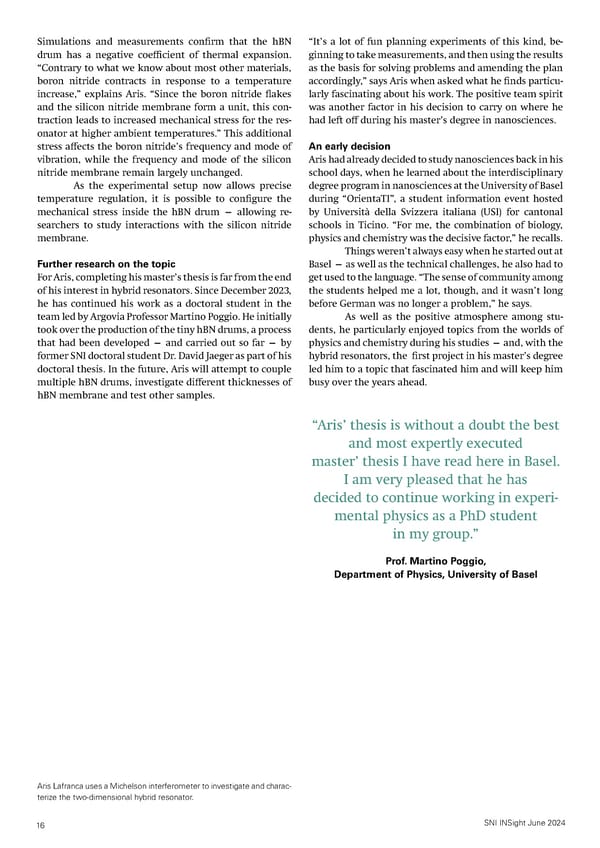
Further Guest article by Michelle Arnet information Fruk Lab Cytochrome c nanoparticles https://www.fruk-lab.com to treat cancer? Master’s project in Cambridge, UK Thanks to an Argovia Travel Grant, I had the opportunity to do my master’s project in the group led by Dr. Ljiljana Fruk (Department of Chemical Engineering and Biotechnology) at the University of Cambridge (UK) — an interdisciplinary molecular and nanoengineering laboratory dedicated to the advancement of green chemistry and biomedical applications. Cytochrome c nanoparticles — c could help to overcome this resistance. potential initiators of cell death Following successful synthesis of cyt c My project required me to work closely with ProNPs, I con昀椀rmed their favorable physi- a doctoral student and a postdoc, who togeth- co-chemical properties using dynamic light er developed an innovative method based on scattering, transmission electron microsco- ultrasonic homogenization to produce pro- py and spectroscopic measurements. I also tein nanoparticles (ProNPs). Their aim was to developed assays to validate the biofunction- transport therapeutic proteins to cancerous al activity of the cyt c ProNPs. We then used tissues more e昀케ciently and with low immu- various cell tests to investigate whether the nogenicity. NPs could induce cell death in cancer cells In my project, I developed and char- and senescent cells. acterized speci昀椀c cytochrome c (cyt c) ProNPs. Since the NPs we developed were un- Cyt c is of interest because it acts as an endog- able to reach the cytoplasm of the two cell enous mediator of cell death. ProNPs based on types, they did not bring about cell death, cyt c may have the potential to eliminate not and we were unable to solve this problem only cancer cells but also “senescent” cells despite multiple modi昀椀cation strategies. — aging cells that can be cancer-inducing if Nevertheless, the analyses provided us with they are located within tumor tissue. Both valuable scienti昀椀c insights and revealed what senescent and cancer cells are resistant to steps were needed to exploit the potential of processes that lead to natural cell death, but this new class of ProNPs. the natural biological function of cytochrome Transmission electron microscopy image of cytochrome c During my time in Cambridge, I had the opportunity nanoparticles produced using ultrasonic homogenization. to present our project in the form of a poster at a con- (Image: M. Arnet) ference of the Royal Society of Chemistry in London. (Image: M. Arnet) SNI INSight June 2024 17
Grants for SNI members
SNI members have reveived grants from different funding sources in recent month.
Extensive new insights and experience Thanks to this interdisciplinary and multifaceted project, I learned a wide range of new scienti昀椀c techniques. Fur- thermore, I was able to practice and improve my skills in the areas of scienti昀椀c planning, discussion and criticism, as well as interpersonal communication. I also had the opportunity to present my project in the form of a poster at a scienti昀椀c conference of the Royal Society of Chemis- try in London. During my time at the Fruk lab in Cambridge, I bene昀椀ted from a highly supportive and motivational working environment, which gave me the opportunity to build friendships with people from all over the world and expand my scienti昀椀c network. Being part of the Uni- versity of Cambridge was an eye-opening and fascinating experience — and, in many ways, it provided me with clarity regarding my future objectives. As well as spending lots of time in the lab, I took the opportunity to visit various places in England, includ- ing Bath, Oxford, the Lake District, Brighton, London and Stonehenge. I enjoyed many evenings in Cambridge and got to experience not just college life, but also British pub culture — complete with “pub grub”, beer and quiz nights. I spent lots of time with the members of my lab, where I made many new friends. (Image: M. Arnet) Funding of SNI members Various grants pave the way for innovative lines of research Numerous SNI members have been awarded grants from various sources in recent months. By providing regular overviews of newly funded research projects, our aim is to keep all researchers in the SNI network informed of the activities of other SNI members. So that we can list the broadest possible selection of awarded grants in SNI INSight, we would be grateful if SNI members could update us regularly. Forces between molecules cial high-speed atomic force microscope (HS-AFM) as part Professor Roderick Lim from the Biozentrum has been of this project. The researchers will then utilize the HS- awarded a COST project by the European Cooperation in AFM to determine the nanomechanical forces exerted by Science and Technology to investigate the forces between speci昀椀c molecules (phenylalanine-glycine nucleoporins = molecules in nanopores. FG Nups) bound in arti昀椀cial nanopores. In natural pores In collaboration with the Nanobiology Institute in the cell nucleus membrane, FG Nups play an important at Yale University (USA), the Lim team is developing a spe- role in facilitating the transport of large molecules into SNI INSight June 2024 18
Further and out of the cytoplasm. By resolving the information nanomechanical forces in the arti昀椀cial pores, the researchers also aim to gain a more com- SNSF prehensive understanding of the impact of https://data.snf.ch/grants/ these forces in natural nanopores equipped grant/220223 Research group with proteins or polymers on the inside. Roderick Lim https://www.biozentrum.unibas. Possible treatment for genetic defects ch/research/research-groups/ Professor Jörg Huwyler from the Department research-groups-a-z/overview/ unit/research-group-roder- of Pharmaceutical Sciences has been award- ick-lim ed a Sinergia project together with research- ers from EPFL and the University Children’s Hospital. SNSF In this project, the researchers In the approved COST project, Roderick Lim’s team is https://data.snf.ch/grants/ grant/10000153 want to develop a new generation of stable, investigating forces between molecules and nanopores long-lasting and safe DNA therapeutics for in- using a special high-speed atomic force microscope. Research group travenous administration. Their initial focus Jörg Huwyler is on treatment options for a rare metabolic https://pharma.unibas.ch/de/ research/research-groups/phar- disorder that is caused by a single genetic maceutical-technology-2253/ defect and primarily a昀昀ects children. in their natural environment. They have To this end, the participating teams a strong antibiotic e昀昀ect and are therefore are planning to develop speci昀椀c lipid nanopar- also of interest for the development of new SNSF ticles that are loaded with DNA plasmids medicines. https://data.snf.ch/grants/per- and bind to speci昀椀c receptors on liver cells. The chemical production of son/542229 Based on in vitro and in vivo experiments, polyketides in the laboratory is complex and Research group the researchers will test the safety and e昀昀ect highly challenging. In microorganisms, on Timm Maier of the developed lipid-based carriers and will the other hand, it is carried out e昀케ciently https://www.biozentrum.unibas. use an animal model to analyze whether this in comparatively large production lines with ch/research/research-groups/ approach o昀昀ers a safe and long-term means many individual, spatially coupled reaction research-groups-a-z/overview/ unit/research-group-timm- of compensating for the studied genetic de- centers. The researchers from the Maier team maier fect. now want to use various state-of-the-art mi- croscopes to investigate the spatial structure Understanding microbial production lines of the natural “polyketide factories” in the In a project supported by the Swiss National cellular environment with a view to under- Science Foundation (SNSF), Professor Timm standing how these factories’ unique organi- Maier’s group is investigating microbial “fac- zation contributes to their functionality. tories” in which bacteria and fungi produce The expected 昀椀ndings will help polyketides. These highly complex chemical researchers to directly optimize or vary the compounds help microorganisms survive cellular production of polyketides. In gen- Researchers from Jörg Huwyler’s team want to develop stable, long-lasting and safe DNA therapeutics for venous administration in a new Sinergia project. (Image: Adobe Fire昀氀y) SNI INSight June 2024 19
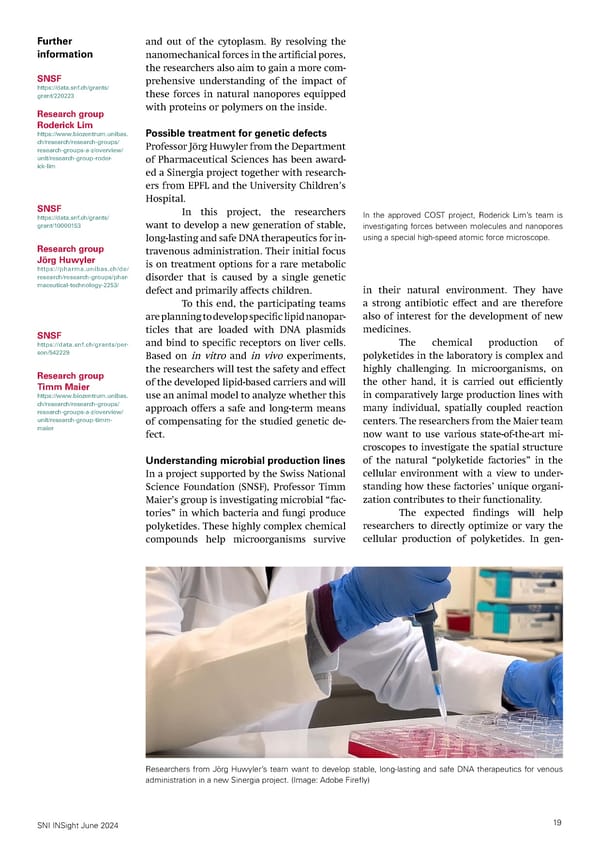
A number of different enzymes (polyketide synthases) are responsible for the production of polyketides in the produc- tion lines in microorganisms. (Image: T. Maier, Biozentrum, University of Basel) eral, however, they will also serve to eluci- perQ, a project of the European Association Further date concepts derived from nature for the of National Metrology Institutes (EURAMET) information development of e昀케cient arti昀椀cial synthesis that aims to develop a new generation of systems on the nanometer scale. metrological methods and tools for super- Research group conducting qubits and quantum materials. Martino Poggio In this project, a consortium of 13 research https://poggiolab.unibas.ch New microscope for quantum materials The research team led by Professor Martino groups from nine European countries began Poggio (Department of Phyiscs, University of work in June 2024 with a view to develop- Basel )was recently awarded an R’Equip grant ing the new tools, which will subsequently by the Swiss National Science Foundation. be applied to superconducting circuits with This grant will be used to develop a novel one or two qubits. These new instruments scanning probe microscope (millikelvin and will enable precise characterization, manip- high-bandwidth scanning SQUID microscope ulation and readout of qubits, thereby laying = mK-SPM) operating at temperatures in the the foundation for further technical progress millikelvin range. A microscope of this kind is in quantum technology. needed to characterize quantum information The Poggio lab is primarily engaged devices and quantum materials at the low in the characterization of qubit components temperatures at which they operate, thereby and quantum materials at low and micro- providing new insights into the development wave frequencies, as well as in the search of quantum devices. for defects in superconducting circuits. To The Poggio team will place the new this end, the researchers employ di昀昀erent mK-SPM in a dilution cryostat and will be able scanning probe microscopes to analyze to cool the microscope down to temperatures qubit components’ electrical and magnetic of 10 millikelvin (-273.14°C). Furthermore, the properties. The researchers will initially researchers will equip the device with the utilize existing microscopes within a tem- necessary electronics to control qubits and perature range of 350 millikelvin and will read sensors with a wide bandwidth. The new subsequently continue their investigations microscope will be compatible with a variety with the newly developed SQUID scanning of sensors, including nano-SQUID magnetom- probe microscope at lower temperatures of eters, multi-gate probes and quantum dot 50 millikelvin — close to the qubits’ operat- (QD) charge sensors. ing temperatures. The various analyses will assist in the evaluation and improvement of Use for characterization components. The Poggio team is also involved in MetSu- 20 SNI INSight June 2024
The approved projects support the work of the researchers in Martino Poggio’s team. Here, Floris Braakman and Katharina Kress work on a cryostat. Further Testing quantum hardware be a user-friendly, simpli昀椀ed and improved information A Propelling Grant from the University of means of producing single photons, which Basel went to the physicists Professor Rich- will then pave the way for industrial applica- University of Basel ard Warburton and Dr. Andreas Kuhlmann as tions. https://www.pupella.org/post/ well as the head of the mechanics workshop, winners-from-the-propelling- grant-2023-announced-cryo- Sascha Martin. The three researchers from New measurement method probe the Department of Physics at the University for microwave signals Research group of Basel are working on founding the start-up Since June 2024, the group of Professor Richard Warburton Cryoprobe. Philipp Treutlein (Department of Physics) https://nano-photonics.unibas. Their aim is to develop a special cryo- has been involved in the OnMicro project of ch genic testing station that will allow rapid and the European Association of National Metrol- Publication precise testing of solid-state quantum hard- ogy Institutes (EURAMET) with the objective https://www.nature.com/arti- ware — in particular, semiconductor-based of developing new on-wafer measurement cles/s41565-020-00831-x qubits. The testing station will operate at very techniques for the characterization of mi- low temperatures and is to be tailored to the crowave signals on semiconductor chips. IDQuantique: special requirements of quantum hardware. The characterization of such chips — which https://www.idquantique.com are used in emerging technologies such as 6G telecommunication, autonomous vehi- Source of single photons cles and wearable electronics — requires Research group Professor Richard Warburton’s group also more-advanced microwave measurement Philipp Treutlein recently launched the Innosuisse project capabilities. https://atom.physik.unibas. SparQ. In this three-year project in collabo- The Treutlein team will now employ ch/en/ ration with the Swiss company IDQuantique, a novel approach utilizing Rydberg atoms as the researchers aim to develop a user-friend- quantum sensors for microwaves in order ly source of single photons. to achieve enhanced accuracy beyond that Single photons have strong quantum which was previously attainable. The Basel properties and are suitable for various applica- researchers are working closely with the tions in quantum technology — for example, Swiss Federal Institute of Metrology (ME- in order to develop secure communication TAS), to which the new technology will be channels (quantum cryptography). Existing transferred after testing. single photon sources are based on elaborate, complicated laboratory experiments. With the Innosuisse project, the researchers now want to ensure that, in the future, there will SNI INSight June 2024 21
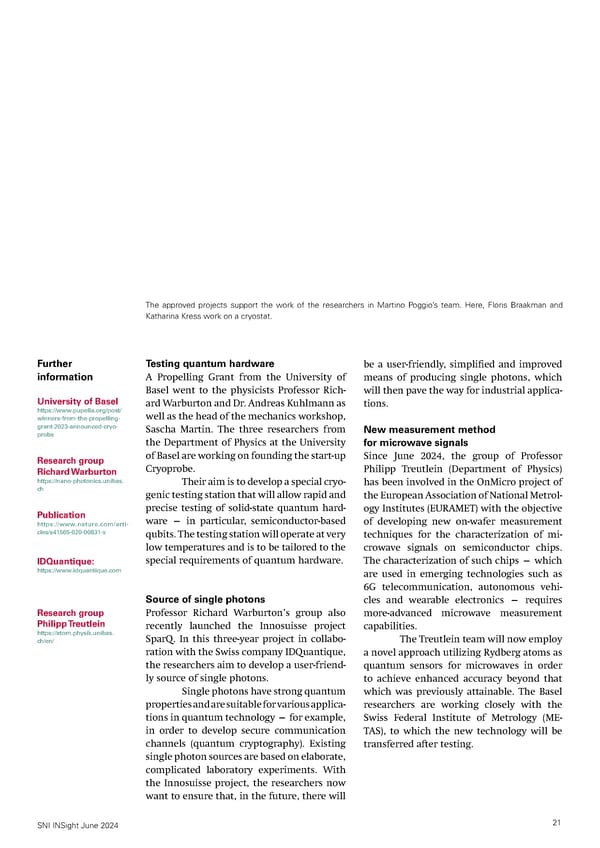
Electron diffraction
ELDICO Scientific, a start-up that was founded in the SNI network, delivered his first electron diffractometer to the MPI für Kohlenforschung in Germany.
Tilman Zibold from the Treutlein team will be working on the EURAMET project OnMicro. Electron di昀昀ractometer from Further information ELDICO Scienti昀椀c ELDICO Scientific First delivery to Germany https://www.eldico-scientific.com The start-up ELDICO Scienti昀椀c, which was founded in 2019 as part of the SNI network, has delivered and installed its 昀椀rst electron di昀昀ractometer in Germany. Based at Park Innovaare, the young company is collaborating with the Max-Planck-Institut (MPI) für Kohlenforschung in Mülheim an der Ruhr. Over the coming months, the researchers in Germany will investigate how ELDICO’s electron di昀昀ractometer can expand the wide-ranging analytical capabilities of the MPI. “Research at the Max-Planck-Institut für Kohlenforschung pushes the boundaries of catalysis, including chemical analysis, to provide a deeper understanding of matter. Electron di昀昀raction using the ED-1 is one of the promising techniques when it comes to obtaining structural information for systems that aren’t yet fully understood.” Dr. Michael Patzer, researcher at the Max-Planck-Institut für Kohlenforschung 22 SNI INSight June 2024
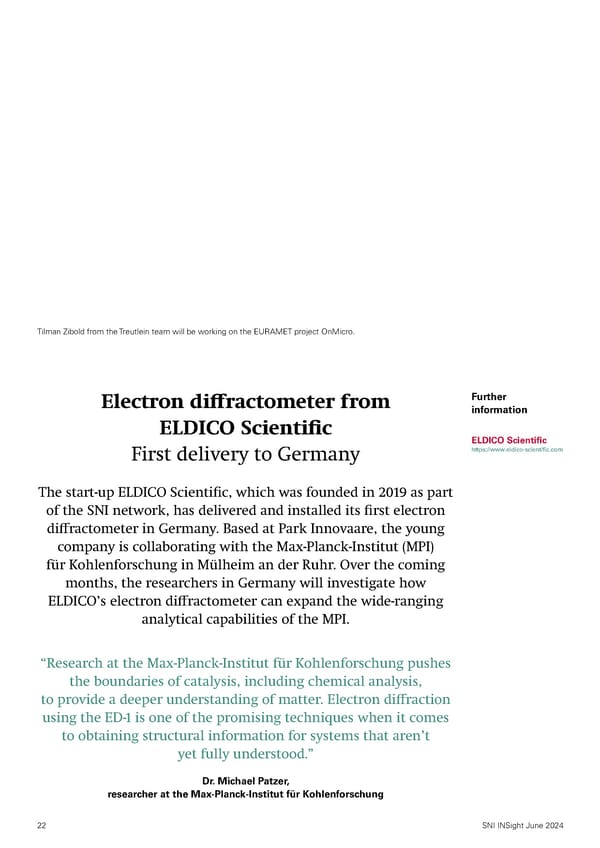
Rooted in a Nano-Argovia project Numerous challenges ELDICO Scienti昀椀c is a start-up that emerged from the Much has happened since ELDICO Scienti昀椀c was founded Nano-Argovia project A3EDPI. As part of the project, an in June 2019, with the young company’s team evolving interdisciplinary team of scientists led by Dr. Tim Grüne alongside advances in device development. Highly qual- (then PSI, now University of Vienna) demonstrated that i昀椀ed new team members — including application scien- the di昀昀raction patterns of electron beams are excellently tists and sales sta昀昀 — have joined ELDICO and are now suited to elucidating the spatial structure of tiny organic seeking to bring the electron di昀昀ractometer to market nanocrystals in powder form — while X-rays or synchro- and collaborating with wide-ranging customers. In paral- tron beams had not led to satisfactory results given the lel, ELDICO continues to work with its engineering and small crystal size. software development team to improve its devices and Based on this positive outcome, ELDICO Scien- make them more user-friendly — and to help shape the ti昀椀c has spent the last four years developing the ELDICO future of crystallography as a market leader in the indus- ED-1 electron di昀昀ractometer, which specializes in precise- try. ELDICO will deploy its next instrument for solid-state ly this kind of analysis of tiny crystals. One of the 昀椀rst analysis in the United States, thereby also expanding its ELDICO ED-1 devices has been available in the “Customer market in geographical terms. Experience Center” at Innovation Park Basel Area for al- most two years. A consortium of four partners supports “With the new team, we’re ideally the platform operated by ELDICO Scienti昀椀c, in which the SNI acts as an academic partner, opening the door to this positioned to support new customers promising technology for its members. such as the Max-Planck-Institut für “Taking measurements at ELDICO is Kohlenforschung, to consolidate our a great opportunity to stay at the market position, and to drive growth forefront of crystallography while ob- with optimized devices.” taining results that are impossible with Dr. Gustavo Santiso-Quinones, founder and senior traditional crystallographic methods.” scientist at ELDICO Scientific Dr. Alessandro Prescimone, Department of Chemistry, University of Basel The inside of the electron diffractometer, ELDICO ED-1, which is now also used by researchers from the Max-Planck-Institut (MPI) für Kohlenforschung in Mülheim an der Ruhr. (Image: ELDICO Scienti昀椀c) SNI INSight June 2024 23
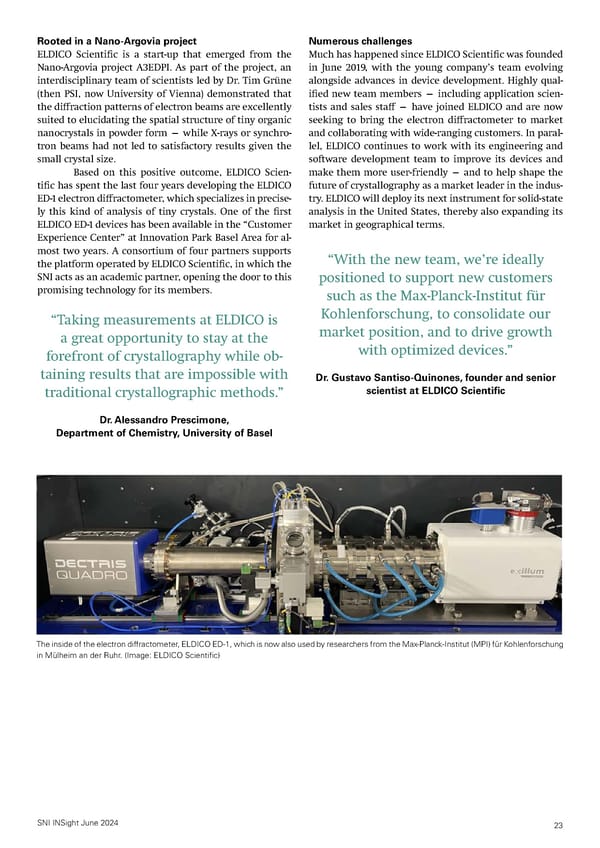
Awards In recent months, SNI members have not only been allocated funding from various sources but have also won a series of awards. For example, Professor Sonja Schmid (Department of Chemistry, University of Basel) received the Young Fluorescence Investigator Award 2024 from the Biological Fluorescence Subgroup at the annual conference of the Biophysical Society in February 2024. This prize is awarded to outstanding young researchers at the start of their careers, in recognition of their work on 昀氀uorescence methods. Sonja Schmid received the Young Fluorescence Inves- tigator Award from the Biophysical Society. (Image: H. Sanabria) At the March Meeting of the American Physical Society (APS), it was announced that our former director and honorary member Profes- sor Christian Schönenberger (Department of Physics, University of Basel) is to be honored as one of the APS Outstanding Referees for 2024. The Outstanding Referee program was launched in 2008 and recognizes scientists who have been exceptionally helpful in assess- ing manuscripts for publication in the APS journals. Each year, this highly selective program recognizes some 150 of the around 91,600 active reviewers. Christian Schönenberger was honored as an APS Out- standing Referee for 2024. Thank you and farewell to Michèle, and welcome to Battist! At the end of June, our long-serving outreach manager Dr. Michèle Wegmann is leaving the SNI to focus more closely on children’s edu- cation as an elementary school teacher. Michèle has been a key contact for outreach activities with children and for parts of the Annual Report, the Nano-Argovia pro- gram and numerous SNI events such as the Annual Event and the NanoTec Apéro. We thank her for her dedication over the last eight years and all of her work to support and advance the interests of the SNI — and we wish her all the best as she takes on this new challenge. The nanoscientist Dr. Battist Utinger will join the SNI’s man- agement team on 1 July. His work will focus on getting pupils and high-school students interested in the nanosciences and informing them about the nanoscience degree with a view to boosting student numbers. Battist will also intensify contact with companies and raise awareness of the SNI’s Nano-Argovia program in Northwestern After eight ful昀椀lling years, Michèle Wegmann is leaving Switzerland, as well as taking over Michèle’s tasks in other areas. We the SNI. Battist Utinger will join the SNI management welcome him and look forward to working together! team in July. 24 SNI INSight June 2024
Swiss NanoConvention 2024
The Swiss NanoConvention 2024 took place at the Congress Center in Basel. Here's a short report about the successful event organized by the SNI.
Further Swiss NanoConvention 2024 information Two inspiring days of all things nano Swiss NanoConven- tion 2024 https://2024.swissnanoconven- Some 300 participants, 60 high-school pupils, 44 talks, 53 posters, tion.ch/university-of-basel Video SNC 2024 seven awards, 15 exhibition stands and 25 sponsors — these are https://youtu.be/d2SxVeCabT0 just some of the 昀椀gures that de昀椀ne SNC 2024. What the 昀椀gures don’t re昀氀ect, however, is the intellectually stimulating yet relaxed atmosphere that provided an opportunity not only to engage in many inspiring conversations but also to forge new contacts and refresh old ones. Over two intensive and interesting days, partic- ipants discussed numerous topics and exchanged knowledge re- garding innovative nanoresearch and nanotechnology applications. Openess is the key The task of organizing the Swiss NanoCon- vention (SNC) is always not just a privilege but also a challenge, and one that the SNI team is happy to embrace. The SNC is all about nanoscience and nanotechnology in terms of both basic science and applications, and covers areas ranging from quantum science to nanomedicine. This diversity pro- vides a unique opportunity to look outside the box, but also calls for speakers and visi- tors to open their minds and take an interest in 昀椀elds other than their own. SNI Director Professor Martino Pog- gio touched on this necessity in his welcome address, in which he invited all participants to “challenge themselves to embrace the diver- In his welcome address, SNI Director Martino Poggio sity of topics and attend talks on less-familiar invited all participants to embrace the diversity of topics subjects” — for this is precisely the particular and attend talks on less-familiar subjects – because this is precisely the particular attraction of the Swiss Nano- attraction of the Swiss NanoConvention. The Convention. chair of the Swiss MNT Network, Dr. Michel Despont, used his welcome address to high- light the active participation of industrial “The Canton of Basel-Stadt sup- companies in the SNC. This o昀昀ers an ideal platform for exchange and communication ports the Swiss NanoConvention between researchers from research institu- because this important exchange tions and companies. of ideas between researchers Contributions by leading scientists from di昀昀erent institutions and As well as promoting diversity in terms of disciplines paves the way for subject matter and exchange across institu- tional boundaries, the program and organiz- innovative solutions to ing team from the SNI was also keen to invite wide-ranging challenges.” leading international scientists to the SNC in Basel with a view to o昀昀ering insights into the Dr. Karin Sartorius, Basel-Stadt Congress latest research 昀椀ndings for the assembled Board, platinum sponsor nanocommunity. It is clear from the list of SNI INSight June 2024 25

keynote speakers that, this year, the team once again as well as the approach of using liposomes to treat dis- succeeded in this objective. turbances in the breakdown of ammonia in the human For example, one of the subjects addressed at the body (Professor Jean-Christophe Leroux, ETH Zürich) — a conference were porphyrins. These naturally occurring subject that has already been studied in clinical trials. pigments, which can serve as molecular building blocks Dr. Marija Plodinec, CEO and cofounder of ARTIDIS, then of nanowires and nanorings, allow e昀케cient charge trans- explained the challenges scientists face when research fer over distances of several nanometers (Professor Harry is successful and an application is to be established on Anderson, University of Oxford). Other topics included the market. ARTIDIS is a Basel-based start-up that uses tiny acoustic resonators that can be coupled with individ- atomic force microscopy to assess the aggressiveness of ual optical photons, making them suitable for numerous cancer cells and therefore facilitate better approaches to applications in the quantum sciences (Professor Simon treatment. Gröblacher, TU Delft), as well as “Cooper pair splitters,” As well as these outstanding keynote lectures, research- which can be used to produce and split entangled elec- ers from Switzerland and abroad gave a further 36 talks trons (Professor Christian Schönenberger, University of in parallel sessions. Chairs from the SNI network had Basel). ensured that this section of the program also featured a Professor Kathryn Moler (Stanford University, top-class selection of researchers presenting their work CA, USA) gave a very clear explanation of what quantum — thereby providing the audience with insights into materials actually are and how best to study them as part the latest research 昀椀ndings and potential applications. of the Güntherodt Lecture, which is held at every instal- During the breaks, the over 50 posters and 15 exhibition ment of the SNC in honor of the Basel-based professor of stands provided numerous face-to-face opportunities for physics and “nanopioneer” Hans-Joachim Güntherodt. participants to 昀椀nd out more, exchange ideas and engage in discussions with researchers. In their keynote lectures, Kathryn Moler and Sébastien Lecommandoux gave exciting insights into their research. Interdisciplinary exchange was the main focus of the SNC.(Image: E. Byrne) «I enjoyed it greatly and it was wonder- ful to have the chance to be in touch with the Swiss Nano/Quantum community.» Prof. Kathryn Moler, Stanford University, CA, USA Other keynote talks dealt with self-assembling poly- mer-based nanovesicles, which can be loaded with ac- tive pharmaceutical ingredients, and the preparation of more-complex, compartmentalized arti昀椀cial cells (Profes- Over 50 posters offered an ideal opportunity to 昀椀nd out about different sor Lecommandoux, University of Bordeaux). Key topics research approaches and to discuss these with the respective research- in the 昀椀eld of nanomedicine included work on the devel- ers during the poster session. opment of microrobots that can indicate various disease parameters (Professor Simone Schürle-Finke, ETH Zürich), SNI INSight June 2024 26
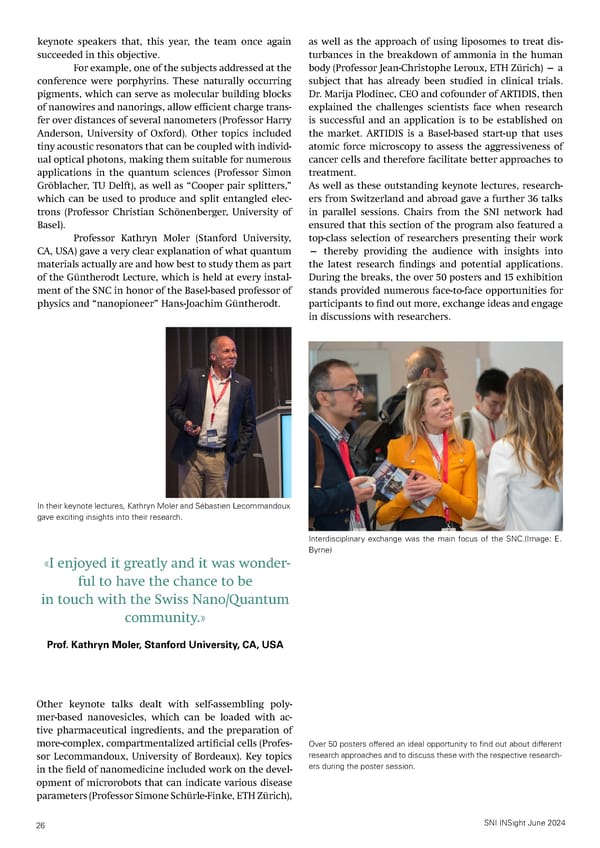
The pupils were 昀椀rst given an introduction to the na- nosciences in specially prepared short talks. Next, they looked at various posters to learn about di昀昀erent lines of research from the corresponding doctoral students and attended one of the SNC talks. Lastly, the pupils could also choose between four di昀昀erent laboratory tours — in the Departments of Physics or Chemistry, the University Center for Dental Medicine, or the Nano Imaging Lab of the SNI — in order to get an idea of the everyday practical work of nanoscientists. Awards for outstanding achievements At the exhibition booth, various players from the Swiss nano community At the end of this year’s SNC, Professor Christian Schönen- provided information about their activities and products. berger presented 昀椀ve Swiss Nanotechnology PhD Awards on behalf of the Swiss MNT Network for outstanding Insights for pupils 昀椀rst-author publications in the nanosciences by doctoral One highlight on the second day of the conference was students from Switzerland in the past year. the visit by 60 school pupils, who gained insights into the This year’s awards, which were sponsored by the world of the nanosciences as part of the event “TecDay companies Bühler, Kistler, IBM Research Europe, Nano- meets Swiss NanoConvention.” This was organized by surf and nano.swiss, went to Petru P. Albertini (EPFL), the SNI’s outreach team in collaboration with SATW and Chenglian Zhu (Empa/ETH Zürich), Dr. Samuel Mendes received sign-ups from pupils from all over Switzerland. Leitão (EPFL), Marco Coraiola (IBM) and Guanhao Huang (EPFL). Martino Poggio then awarded the prizes for the best poster presented at the SNC (Aura Maria Moreno Echeverri, AMI) and for the two winning entries for the most beautiful images from the nano and microworld (Daniel Mathys, Marcus Wyss, SNI). After an intensive two days of all things nano, Poggio then bid the participants farewell and extended his thanks to the speakers, chairs, sponsors, exhibitors, student assistants, organizers and participants. He also invited those present to save the date of the next Swiss NanoConvention, which will be held at the FHNW Campus in Brugg on 12-13 June, 2025. Sixty Swiss school pupils visited the SNC as part of “TecDay meets Swiss NanoConvention” and gained an insight into the world of science and nanotechnology. At the end of the SNC, 昀椀ve doctoral students (or a representative in their absence) received the Swiss Nanotechnology PhD Award from the “We’re impressed by the scale of the various sponsors. In addition, the prizes for the best poster and the most beautiful picture were announced. Swiss NanoConvention, and we’re learning lots about nanotechnology, which plays a role in a surprisingly large number of areas — there’s still so much to explore.” Ylenia and Elinor, Schaffhausen Cantonal School SNI INSight June 2024 27
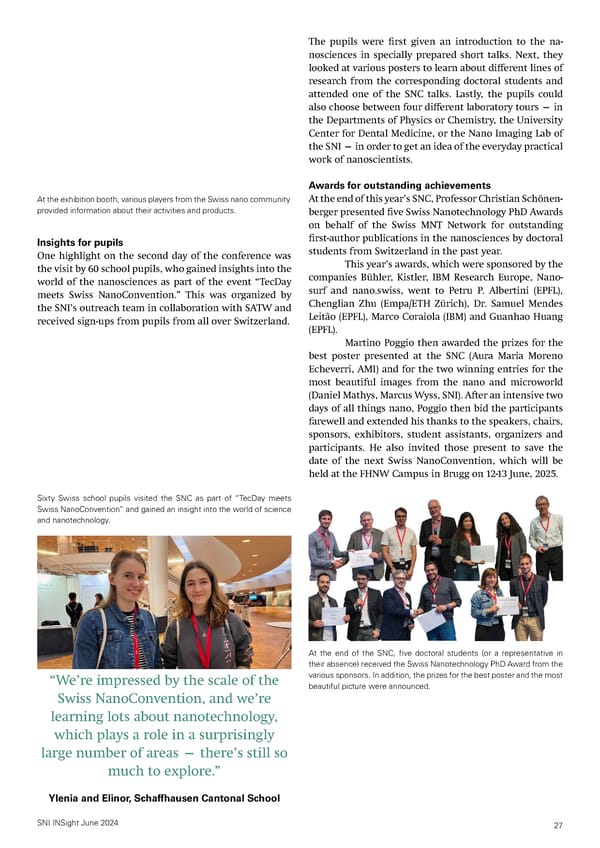
News from the SNI network Superconducting qubits – voltage tuned Researchers from the SNI network have developed a new qubit platform that could be suitable for various applica- tions. In contrast to conventional superconducting qubits made of metals, the team has combined a technologically relevant semiconductor with superconducting elements to create a “gatemon” qubit with promising properties. SNI post: https://nanoscience.unibas.ch/en/news/details/mit-spannung-getunte-supraleitende-qu- bits// The researchers from Basel have fabricated a high-quality Josephson Original publication: junction on a germanium/silicon nanowire between two superconduc- https://pubs.acs.org/doi/10.1021/acs.nanolett.4c00770 tors (black and white image top right) and thus produced the central part of a “Gatemon” qubit. (Image: H. Zheng, Department of Physics, University of Basel) Artificial intelligence calculates phase diagrams Researchers at the University of Basel have developed a new method for calculating phase diagrams of physical systems that works similarly to ChatGPT. This arti昀椀cial intelligence could even automate scienti昀椀c experiments in the future. University of Basel post: https://www.unibas.ch/en/News-Events/News/Uni-Research/Arti昀椀cial-intelligence-calcu- lates-phase-diagrams.html Methods of generative arti昀椀cial intelligence can be suitable for quickly Original publication: calculating phase diagrams of many-body systems. (Image: generated https://journals.aps.org/prl/abstract/10.1103/PhysRevLett.132.207301 with ChatGPT) Researchers realize a two-qubit gate in a silicon transistor Researchers from the University of Basel and the NCCR SPIN have achieved the 昀椀rst controllable interaction between two hole spin qubits in a conventional silicon transistor. The breakthrough opens up the possibility of integrating millions of these qubits on a single chip using mature manufacturing processes. University of Basel post: Two interacting hole-spin qubits: As a hole (magenta/yellow) tunnels https://www.unibas.ch/en/News-Events/News/Uni-Research/Experiment-opens-door-for- from one site to the other, its spin rotates due to spin-orbit coupling, millions-of-qubits-on-one-chip.html leading to anisotropic interactions represented by the surrounding bub- Original publication: bles. (Image: NCCR SPIN) https://www.nature.com/articles/s41567-024-02481-5 SNI INSight June 2024 28
Method for detecting nanoparticles in early life nutrition Researchers from the SNI network have developed a technique that can detect nanoparticles (that is, particles with a diameter of less than 100 nanometers) in early life nutrition products with a high sample throughput. SNI post: https://nanoscience.unibas.ch/en/news/details/methode-zum-nachweis-von-nanopartike- ln-in-lebensmitteln-fuer-kleinkinder/ Original publication: Colorized TEM Image of SiNP (green) in the matrix (orange), scalebar = https://pubs.acs.org/doi/10.1021/acsomega.3c09459 400 nm. (Image: S. Saxer, FHNW) Strong spin-photon coupling Researchers from the SNI network have achieved strong coupling between an electron spin and a single photon. Normally, an electron spin couples only weakly to pho- tons. To achieve strong coupling with a single photon, the researchers used a special indium arsenide crystal structure. This couples the electron spin naturally to its motional degree of freedom thereby making it open to interaction with a microwave photon. SNI post: Using a complex experimental setup, researchers from the SNI network https://nanoscience.unibas.ch/en/news/details/starke-spin-photonen-kopplung/ have achieved strong coupling between an electron spin and a photon. Original publication: (Image: A. Pally, Department of Physics, University of Basel) https://www.nature.com/articles/s41467-024-45235-w Increased coherence thanks to cooling A team of researchers from the SNI network has increased the coherence of an electron spin in a quantum dot to over half a microsecond for the 昀椀rst time. The scientists achieved the more than 150-fold increase in coherence time by using the electron spin-nuclear spin interaction, which causes the spin system to cool down to 100 mi- crokelvin. SNI post: https://nanoscience.unibas.ch/en/news/details/dank-kuehlung-erhoehte-kohaerenz/ Original publication: https://journals.aps.org/prl/abstract/10.1103/PhysRevLett.131.210805 By drastically reducing the 昀氀uctuations of the nuclear spins, the coher- ence time of the electron in the quantum dot can be increased. (Image: Department of Physics, University of Basel) SNI INSight June 2024 29
Mass-producible miniature quantum memory Researchers at the University of Basel have built a quan- tum memory element based on atoms in a tiny glass cell. In the future, such quantum memories could be mass-produced on a wafer. University of Basel post: https://nanoscience.unibas.ch/de/news/details/massenproduzierbarer-mini-quantenspeicher/ Original publication: https://journals.aps.org/prl/abstract/10.1103/PhysRevLett.131.260801 Light pulses can be stored and retrieved in the glass cell, which is 昀椀lled with rubidium atoms and is only a few millimeters in size. (Image: Uni- versity of Basel, Department of Physics/Scixel) Using light to produce medication and plastics more efficiently Anyone who wants to produce medication, plastics or fer- tilizer using conventional methods needs heat for chem- ical reactions – but not so with photochemistry, where light provides the energy. The process to achieve the de- sired product also often takes fewer intermediate steps. Researchers from the University of Basel are now going one step further and are demonstrating how the energy e昀케ciency of photochemical reactions can be increased Radicals generated by light can only unfold their reactivity as soon as tenfold. More sustainable and cost-e昀昀ective applications they break out of a kind of “cage” that the solvent forms around them. are now tantalizingly close. Researchers in Basel show how to make this “cage escape” more suc- cessful and how it leads to more ef昀椀cient photochemistry. (Illustration: University of Basel post: University of Basel, Jo Richers) https://www.unibas.ch/en/News-Events/News/Uni-Research/Using-light-to-produce-medi- cation-and-plastics-more-ef昀椀ciently.html Original publication: https://www.nature.com/articles/s41557-024-01482-4 Communication workshop Eight doctoral students from the SNI PhD School took part in a workshop on rhetoric and communication in June. Using numerous illustrative examples, science journalist Atlant Bieri showed what is important in communication and how even complex content can be shared clearly and comprehensibly - in a way that everyone will remember. SNI post including short video https://nanoscience.unibas.ch/en/news/details/rhetorik-workshop-2024/ In a two-day workshop, doctoral students at the SNI PhD School learn what is important when it comes to communication. SNI INSight June 2024 30
SmallTalk 2024 On May 15, the “SmallTalk” conference for bachelor’s stu- dents in nanosciences took place.The students each give a short talk on one of their block courses and present a poster on another block course. They organize the event in advance, put together the program, advertise and mod- erate the various sessions. SNI post: https://nanoscience.unibas.ch/en/news/details/smalltalk-2024/ Every year, the bachelor’s students in nanosciences present the results from the block courses as part of “SmallTalk”. Resistant vines in times of climate change The trinational project WiVitis revolves around sustain- able viticulture and concepts that help vineyards tackle the challenges of climate change. Switching over to re- sistant vine varieties that are adapted to climate change seems an inevitable step. Now, the WiVitis project is col- Scanning electron micrographs of shock-frozen grapevine leaves infest- lecting data on the stability of the berries’ skins as a key ed with downy mildew and powdery mildew. (Image: Nano Imaging Lab, factor in grape health at various locations in the Upper SNI, University of Basel) Rhine region and in all weather conditions. SNI post: Recently, the project partners from Germany, France and https://nanoscience.unibas.ch/en/news/details/widerstandsfaehige-reben-in-zeit- Switzerland got together for a project meeting in order to en-des-klimawandels/ consolidate strategies for data collection, discuss experi- mental setups and agree on protocols for the 2024 season. Diverse examples of projects in the Nano Imaging Lab The Nano Imaging Lab user event took place in April. In short presentations, six researchers described their research approaches and how they are supported by the Nano Imaging Lab team. The range of research topics re- 昀氀ected the wealth of tasks that the NI Lab deals with on a daily basis. SNI post: https://nanoscience.unibas.ch/de/news/details/vielfaeltige-beispiele-von-projekten-im-na- no-imaging-lab/ The Nano Imaging Lab User Event was a great opportunity to hear from other research groups, learn more about the diverse capabilities of the Nano Imaging Lab and witness the honoring of the Nano Imaging Lab’s two thousandth customer. SNI INSight June 2024 31
SNI INSight — Showcasing research and activities of the Swiss Nanoscience Institute Concept, text and layout: C. Möller, M. Poggio Translations and proof-reading: UNIWORKS (Erlangen, Germany) Image credits: C. Möller and named sources © Swiss Nanoscience Institute, June 2024 Educating Talents since 1460. Swiss Nanoscience Institute University of Basel University of Basel Petersplatz 1 Klingelbergstrasse 82 4001 Basel 4056 Basel Switzerland Switzerland www.unibas.ch www.nanoscience.ch

